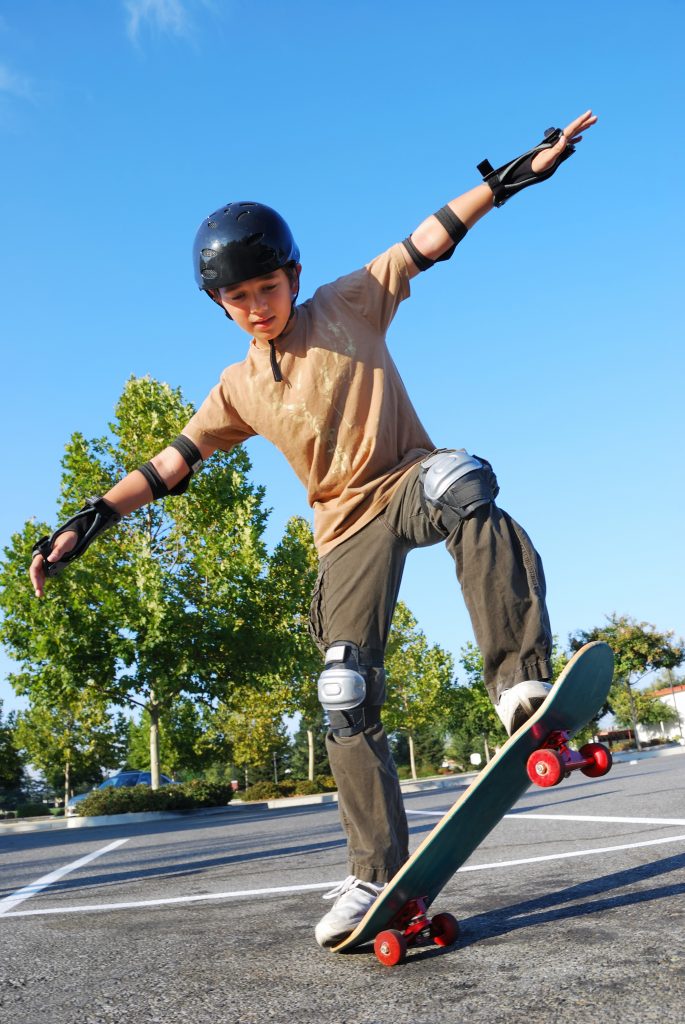Because of the advanced physical demands, skateboarding is recommended only for children ages five and up, and children ages five to 10 should always be supervised.
Children are most likely to get hurt when they are just learning to ride, going too fast, riding near cars and traffic or not using safety gear.
Choosing a skateboard
- Beginners should look for shorter decks as these are easier to balance and handle.
- Choose a wider board to maximize your support. Cover the deck with a non-skid surface to get better traction and control.
- Look for laminated boards, which are generally considered safer than plastic ones because plastic ones frequently break.
- Wider trucks will provide better stability and vibration absorption.
- Larger wheels with rounded edges provide better control.
- Make sure the bearings are singly or doubly sealed to prevent them from falling out and dirt from entering the bearing housing.
Safety tips
- Avoid skateboarding on city streets, public sidewalks and parking lots. Skateboard only in supervised, specially designed skateboarding parks.
- Never skateboard in darkness or wet weather.
- Practise complicated tricks in a specially designed area.
- Acquire proper balance and co-ordination before attempting to skateboard.
- Only skateboard when in good physical condition.
- Do stretching and conditioning exercises before and after skateboarding.
- If you lose your balance while skateboarding, crouch down on the skateboard to reduce the height of the fall and try to land on the fleshy parts of the body. Try to relax your body during a fall and try to roll instead of absorbing the force with your arms.
- Do not get towed by bicycles or motor vehicles.
- Don’t skateboard faster than your experience allows or faster than the conditions permit.
Protective equipment
Helmets

- A properly fitted and correctly worn skateboarding helmet can cut the risk of traumatic brain injury by 45 per cent.
- There are special helmets just for skateboarding. Skateboarding helmets cover more of the back of the head and will protect against more than one crash. Because falls are common in skateboarding, these helmets are made of material that is specially designed to withstand multiple impacts on the same spot.
- Be aware that a skateboarding helmet should not be used for bike riding unless specified on the label.
- Read more about helmets.
Other equipment
- Wrist guards can help protect from broken bones and sprains of the wrist and arm by absorbing the shock and keeping the wrist from bending back if a rider falls. The most common injuries while skateboarding are broken bones and sprains.
- Elbow pads and knee pads may also protect from injuries, but there is little research to show that they are effective.
Skate parks
- Skate parks can provide a safer environment by keeping children away from traffic, uneven roads and sidewalks.
- Injuries still occur at skate parks because children may attempt more-risky tricks and feel more competition with others at the park.
- Researchers have yet to determine whether, on balance, skate parks prevent more injuries than they provoke. Using skate parks is associated with a lower risk of traumatic brain injury.
Risk factors to consider
- Age and sex: by far, the most traumatic injuries related to skateboarding are sustained by those under 20 years old. Males are also at greater risk of sustaining injuries, including traumatic brain injuries, than females.
- Experience: the less experienced a skateboarder is, the more prone they are to injury.
- Environmental hazards: a research study discovered that irregular riding surfaces accounted for more than half of skateboarding injuries due to a fall.
- Protective equipment: protective equipment, including a helmet, can help reduce the number and severity of injuries as they absorb the impact of the fall.
